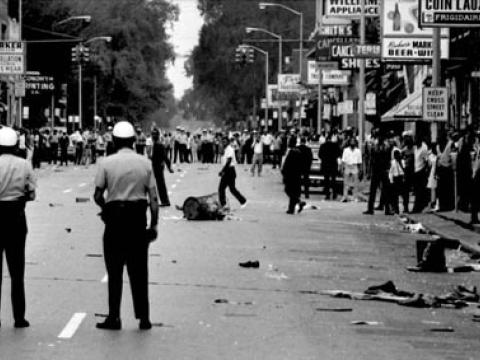Book review from Black Flag #218 1999.

Libcom note: We host a PDF of the book here.
Detroit — I Do Mind Dying presents the history of the League of Revolutionary Black Workers, described by the socialist activist Manning Marable, in the book's introduction, as "in many respects the most significant expression of black radical thought and activism in the 1960s”. At a time when even reactionary politicians such as Richard Nixon were embracing the slogan 'Black Power', the League represented a militant black perspective calling for the fundamental socialist transformation of American society."
The League's roots were in the 1967 Detroit uprising, which led to over 3,800 arrests and the military occupation of Detroit by the Michigan National Guard. In the aftermath of the Great Rebellion, a group of activists began to produce a newspaper, Inner City Voice (ICV), which set its goal as being the production of a revolutionary paper produced by, and written in the language of the urban black working class. The ICV's agenda was set out in one of its first editorials:
In the July Rebellion we administered a beating to the behind of the power structure, but apparently our message didn't get over... We are still working, still working too hard, getting paid too little, living in bad housing, sending our kids to sub-standard schools... only a people who are strong, unified, armed and know the enemy can carry on the struggles which lay ahead of us. Think about it, brother, things ain't hardly getting better. The Revolution must continue."
Detroit's massive auto plants were built on "niggermation”— the super-exploitation of the black working class. As the ICV described it
"Black workers are tied day in and day out, 8 - 12 hours a day, to a massive assembly line, an assembly line that one never sees the end or the beginning of but merely fits into a slot and stays there, swearing and bleeding, running and stumbling, trying to maintain a steadily-increasing pace. Added to the severity of working conditions are the white racist and bigoted foremen, harassing, insulting, driving and snapping the whip over the backs of thousands of black workers, who have to work in these plants in order to eke out an existence."
The ICV collective set out to smash niggermation in Detroit. One of the key icy activists was General Gordon Baker, who worked at Dodge Main, an assembly plant of Chrysler Corporation. Baker pulled together a group of workers who began to meet at the ICV offices. Within ten months of the Detroit Rebellion, the group around the ICV had begun to hit back at the auto industry. On a May 1968,14000 auto workers shut down Dodge Main in the first wildcat strike to hit the factory in 14 years. The immediate cause was 'speed-up' and the driving force behind the strike was the ICV group, which now named itself DRUM (the Dodge Revolutionary Union Movement). DRUM inspired the initiation of other independent black workers' groups, FRUMI at Ford's massive River Rouge plant, and ELRUM at Chrysler's Eldon Avenue Gear and Axle Plant. Other RUMs were established in the steel mills of Birmingham, and the auto plants of Freemont, California and Baltimore, Maryland. The Detroit RUMs coalesced into the League of Revolutionary Black Workers.
The League's activities were a real threat to the effective operation of capital in Detroit. The auto industry arrayed a mass of police, private security and white union members to physically smash the League, but through a combination of discipline and militancy, the League continued to wage "the revolutionary struggle of the ghetto." At one point, a fascist group, Breakthrough, attempted to disrupt an ICV public meeting. The paper tersely reported, "Lobsinger (the Breakthrough organiser) found one of his followers laying in the lavatory in a pool of his own blood."
The success of the League, as the book explains, was in part the cause of its downfall. Students linked to the League took editorial control of the South End, the Wayne State University campus newspaper, and turned the paper into a voice for "the interests of impoverished, oppressed, exploited and powerless", with a daily run of 18,000. From there, the League produced a film, Finally Got the News, and through the involvement of radical black lawyer Ken Cockrel, entered into community organisation against police oppression which culminated in League supporter Justin Ravitz becoming a Recorder's Court Judge. In moving the focus of struggle to the cultural/community arena, the League neglected its industrial base, activists began to drift away to other groups, and the League shattered as individual activists became locked into cultural-political agendas, each arguing for the importance of his/her forum over other League activities. As League activist Mike Hamlin sums up,
"The League began to recruit large numbers of students and professionals. I think that our understanding of proletarian consciousness at that time was very low and we did not do a good job of transforming the understanding of our new members. We were held together by personal loyalties rather than ideology... Community organising and industrial organising are linked up. They go together. The working class should lead the community effort."
It is easy, at a time when working class self-activity is at such a low level, to focus on the failures of the League. Yet the its achievements, the extent of its success, the threat it posed to Detroit capital, and the political alternative it represented (a syndicalist Marxism) to the student-orientated Maoism of the us left, have been a resource for labour and community activists in Detroit through to today. Detroit — I Do Mind Dying is proof, faced with a middle reformist left, of how working class rage can hit its class enemy effectively. At its best the League was an inspiring example of what working class revolutionary organisation really looks like.






Comments